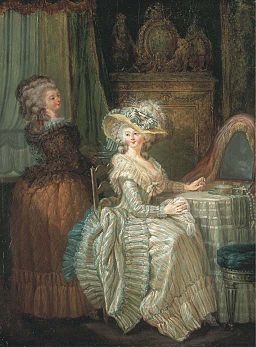Tags
18th Century, banquet, Beau Monde, Bon Ton, decadence, decadent, Eighteenth Century, Georgian, Ghastly Affair, gothic game, Gothic Gaming, Gothic Horror, Gothic Literature, Gothic Romance, Gothick, High Society, mannerpunk, Napoleonic, Regency, role-playing game, Romance, Romantic Horror, rpg, scenerio, story seeds
The Ghastly Age (1765 – 1820) was an odoriferous time. Modern life in the West has been largely scrubbed of the type of smells that were once part of everyday life – eviscerated animals, open sewers, unwashed bodies, and horse excrement. While Marie-Antoinette and Napoleon both took perfumed baths almost every day, even most other aristocrats found it difficult to manage a daily immersion. To cover up any personal body odor, and counteract the foul smells all round them, wealthy people of the 18th century drenched themselves in perfume. An aristocrat might wash their face, hands, feet, and intimate areas with perfumed water, put on a perfumed chemise or undergarment, apply perfume to their skin, and perfume their hair (or wig). Ordinary items, such as books and bedding, were often scented. Leather gloves were almost always scented as well, and pastilles of perfumes were burnt in bedrooms to counteract the smell of chamber pots (and the stink of the streets).
Remember that before the Victorian age, it was not considered unsophisticated for a woman (or man) to wear a single scent, such as rose or musk. Josephine Bonaparte, for example, often wore just jasmine or violet. Some more-or-less standardized mixtures, such as the citrusy Eau de Cologne (beloved by Napoleon) were popular. Most aristocrats, however, had their own perfumes mixed especially for them. Scents for men could be much more floral and sweet than would be considered “masculine” today. Likewise, women’s perfumes often featured deep musk, and other animal smells. The wearing of heavy perfume did not go out of style for men until after the English dandy (and fashion dictator) “Beau” Brummell started appearing in society smelling only of freshly laundered clothes.
Perfumers, Aristocrats, and characters with an Asset such as “Connoisseur of Perfumes”, will all be able to pick out the separate notes of a scent. Someone benefiting from a preternaturally Enhanced Sense of Smell might be able to not only analyze the odor, but also discern the origin of the materials, know when the perfume was applied, and deduce the wearer’s activities since application! An uneducated footpad, however, might only know whether or not someone smells nice.
What Does This Aristocrat Smell Like?
For Women: Roll 1d6 times on Floral Scents, and 1 time on Non-floral Scents.
For Men: Roll 1d6 times on Non-floral Scents, and 1 time on Floral Scents.
Floral Scents (d10)
1 | Geranium
2 | Jasmine
3 – 4 | Lavender
5 | Lilac
6 | Narcissus (Daffodil)
7 | Orange Blossom
8 | Rose
9 | Tuberose
10 | Violet
Non-Floral Scents (d100)
1 | Amond
2 | Anise
3 | Balsam
4 – 5 | Bitter Orange
6 – 10 | Body Odor (from not having bathed recently)
11 | Cedar
12 | Cinnamon
13 – 22 | Civet (a deeply musky and somewhat sweet odor)
23 | Cloves
24 | Earth (from Patchouli)
25 | Frankincense
26 | Fruity Wood (from agarwood)
27 | Ginger
28 | Grapefruit
29 | Hay (from tonka beans)
30 | Honey
31 | Juniper
32 – 36 | Leather (from castoreum)
37 – 38 | Lemon
39 – 40 | Lime
41 | Mint
42 | Moss
43 – 60 | Musk (from the scent pods of asian musk deer)
61 | Myrrh
62 | Nutmeg
63 | Peach
64 | Pine
65 – 66 | Rosemary
67 | Sage
68 – 72 | Sex (from recent lovemaking in their clothes. Eighteenth century people generally had sex without fully undressing. Some libertines might purposefully do this to impregnate their clothing with the scent.)
73 | Smoke
74 –79 | Sweat (from exertion, being near open flames, or perhaps anxiety. Some might deliberately get themselves sweaty. Casanova and Napoleon, for example, both loved the smell of a woman’s sweat)
80 – 89 | Sweet Earth (from ambergris)
90– 91 | Sweet Orange
92 | Sweet Wood (from oakmoss)
93 | Tangerine
94 | Tobacco
95 | Vanilla
96 – 100 | Wood (from vetiver)
The Politics of Perfume
Perfume was so closely associated with the aristocracy that it was actually made illegal in Revolutionary France. Consequentially, it became fashionable to defy the law by wearing especially heavy scents. The gangs of anti-revolutionary young men who terrorized the streets of Paris after the fall of Robespierre were called “Muscadins”, after the musk perfume they wore. The “Incroyables” and “Merveilleuses” who haunted the Palais-Royal during the Directory era (and also affected Royalist politics) wore perfume to be fashionably defiant. The association between scents and politics in France continued under Napoleon, when perfume was made legal again, and the violet became a symbol of the Bonapartists. After his first exile to Elba, Napoleon said he would “return with the violets”. During that time Bonapartists would identify each other by wearing the flower in their clothing, and the perfume on their skin.


The wearing of heavy perfume did not go out of style for men until …
It still isn’t – it’s just called aftershave now. 🙂
Touché!